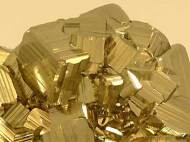Pyrite could be used to generate solar power after all
 Although it has been referred as “fool’s gold” throughout the history, dating to times of ancient Rome and tricking prospectors for centuries, yellow-toned mineral pyrite found its use as an inexpensive and promising option for solar energy. Oregon State University (OSU) researchers discovered related compounds that use the advantages of the material without the downsides it tends to have.
Although it has been referred as “fool’s gold” throughout the history, dating to times of ancient Rome and tricking prospectors for centuries, yellow-toned mineral pyrite found its use as an inexpensive and promising option for solar energy. Oregon State University (OSU) researchers discovered related compounds that use the advantages of the material without the downsides it tends to have.
For more than quarter of a century, researchers have known that pyrite has some desirable qualities that are beneficial for solar energy, but it hasn’t been able to convert the solar energy into electricity in an effective manner. OSU researchers discovered that pyrite starts to decompose and forms products that prevent the creation of electricity once it is exposed to large amount of heat used in the solar cell production process.
Based on their new understanding of exactly what the problem was, the research team then sought and found compounds that had the same capabilities of pyrite but didn’t decompose. One of them was iron silicon sulfide.
“Iron is about the cheapest element in the world to extract from nature, silicon is second, and sulfur is virtually free”, said Douglas Keszler, a distinguished professor of chemistry at OSU. “These compounds would be stable, safe, and would not decompose. There’s nothing here that looks like a show-stopper in the creation of a new class of solar energy materials.”
The work was done at the Center for Inverse Design, a collaborative initiative of the College of Science and College of Engineering at OSU, and it will be continued at the National Renewable Energy Laboratory in Colorado, which collaborated on this research.
“There’s still work to do in integrating these materials into actual solar cells”, said Keszler. “But fundamentally, it’s very promising. This is a completely new insight we got from studying fool’s gold.”
These compounds would be benign and could be processed from some of the most abundant elements on Earth, contrary to other currently available solar cell materials which are rare, expensive or toxic. Pyrite does have an enormous capacity to absorb solar energy and it could be used in layers 2,000 times thinner than some of its competitors on the current solar power generation market.
“The beauty of a material such as this is that it is abundant, would not cost much and might be able to produce high-efficiency solar cells”, Keszler added. “That’s just what we need for more broad use of solar energy.”
For more information, read the article published in journal Advanced Energy Materials named: “Iron Chalcogenide Photovoltaic Absorbers“.









New way to harness solar power!
Dr.A.Jagadeesh Nellore(AP),India
E-mail: anumakonda.jagadeesh@gmail.com